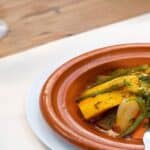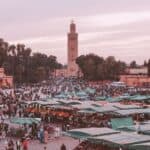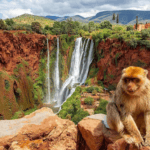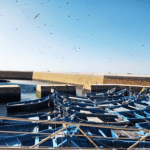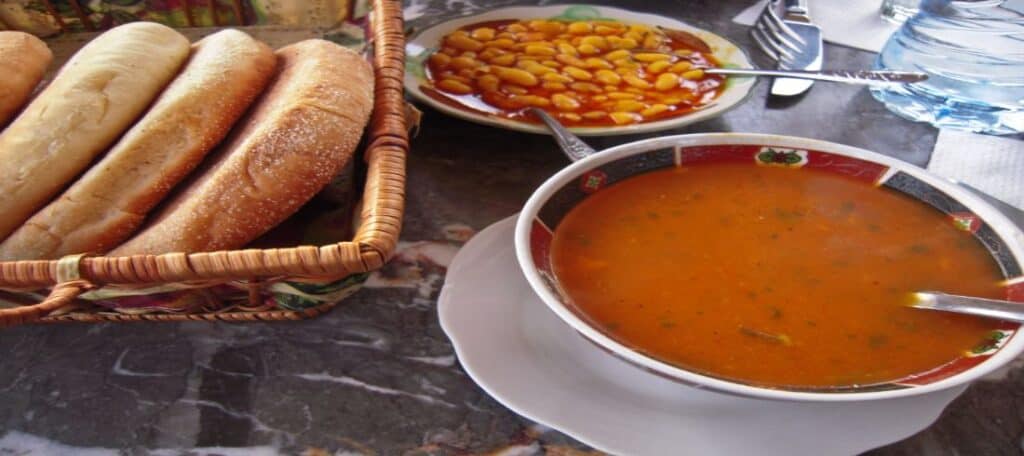
Did you know Harira soup transforms in flavor overnight? It’s a traditional dish, loved in Morocco and Algeria. The rest enhances its rich taste. Known for hearty and nutritious ingredients, Harira is more than just soup. It’s a piece of Moroccan culture, a cornerstone in authentic recipes.
Harira shines during Ramadan but is enjoyed all year. It wraps you in warmth with every bite.
Discovering the Richness of Harira Soup
Harira soup is a cornerstone in Moroccan homes, especially during Ramadan. Almost every family has their unique way of making it, reflecting their history. As Ramadan starts, households gather for suhoor before sunrise, preparing for the day’s fast.
The Culinary Heritage of Traditional Moroccan Harira Soup
Harira soup has deep roots in Moroccan culture, differing from one town to the next. It carries stories and traditions of many families. This soup has passed through generations, changing with the tastes of those who make it.
Understanding the Aromatic Spice Blend Unique to Harira
The flavor of Harira comes from spices like turmeric and cinnamon. These spices create a unique taste that celebrates Moroccan tradition. This blend makes simple ingredients stand out during big celebrations.
The Nutritious Ingredients in a Heartwarming Bowl of Harira
Harira is made with lentils, chickpeas, and tomatoes, offering plenty of nutrients. These ingredients cook into a thick broth, a signature of the dish. Despite rising tomato prices during Ramadan, Harira remains a fulfilling meal.
Cultural Significance of Harira During Ramadan
Harira symbolizes reflection and unity during Ramadan. It’s a key part of the meal that breaks the fast each night, paired with dates. It’s more than soup; it’s a sign of solidarity, showing the strength of Moroccan people during this holy month.
Step-by-Step Guide to Preparing Authentic Harira
Start a cooking adventure with our authentic Harira recipe. It’s rich in flavors that are key to Moroccan cooking. This guide will help you make Harira easily at home.
- Ingredient Preparation: First, get fresh veggies and meats. Chop onions, tomatoes, celery, and cilantro. Then measure out lentils, chickpeas, and rice. For a traditional flavor, cut lamb or beef into small pieces.
- Meat Cooking (optional): Brown the meat in a big pot with some olive oil. When seared well, take the meat out and set aside for later use in the soup.
- Spice and Seasoning: In the same pot, cook onions till they are clear. Then add spices like ginger, turmeric, and cinnamon. This will bring out their strong flavors.
- Base Assembly: Add the meats, veggies, lentils, and chickpeas to the spiced onions. Cover with water and simmer gently. This mixes the flavors well.
- Simmering the Soup: Let the Harira cook slowly, stirring now and then. As it cooks, the soup will thicken and the smells will fill your kitchen. Taste and adjust the seasoning as you like.
- Final Touches: Near the end, add rice or noodles to add texture. A bit of fresh lemon juice will add brightness. Finish with chopped cilantro for a fresh touch.
Conclusion
In the rich food world of North Africa, Harira soup shines as a key Moroccan dish. It shares the stage with delicacies from Algeria and Tunisia. This soup is a true reflection of Morocco’s love for deep flavors and nutritious meals. Made with chickpeas, lentils, spices, meat, tomatoes, and lemon juice, Harira is both tasty and healthy. It improves digestion and can prevent constipation.
When Ramadan comes, Harira gains even more importance. Moroccan women serve it in stunning vessels as part of Ramadan’s celebrations. It’s made without pork or alcohol, following Islamic rules. This shows its crucial role in both Moroccan cuisine and religious traditions. This way of making and serving Harira makes it a special end to fasting days.
As we wrap up our look at Harira, we see it’s not just a meal. It’s a way to dive into Moroccan culture. It brings together taste, health, and tradition. Harira is not just for Ramadan; it’s loved all year. This soup celebrates Morocco’s culinary skills and rich heritage.




